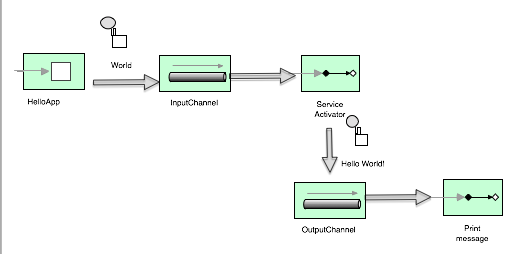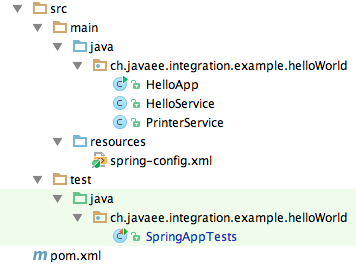

Spring Integration Hello World tutorial
source link: https://marco.dev/2013/04/20/spring-integration-hello-world-tutorial/
Go to the source link to view the article. You can view the picture content, updated content and better typesetting reading experience. If the link is broken, please click the button below to view the snapshot at that time.

java-version.com: What's new in Java 16? 15? Keep up to date!
Spring Integration Hello World tutorial
Here you can find another Hello World example that shows the first steps to build a Spring Integration application.
In our example we create a new Java application that send a message ‘World’ to a channel, a Spring service receives and modifies this string (‘Hello World!’). Eventually and the message is sent to a print service through a second channel.
The structure of the application is very simple:
You can find all the code on gitHub: https://github.com/marco76/SpringIntegrationExamples
The project is build with maven (and developed using IntelliJ). In the pom.xml you have to import the usual libraries and Spring Integration:
<dependency>
<groupId>org.springframework.integration</groupId>
<artifactId>spring-integration-core</artifactId>
<version>2.2.3.RELEASE</version>
</dependency>
The spring-config.xml configure the channels used by the application:
<?xml version="1.0" encoding="UTF-8"?>
<beans xmlns="https://www.springframework.org/schema/beans"
xmlns:xsi="https://www.w3.org/2001/XMLSchema-instance"
xmlns:context="https://www.springframework.org/schema/context"
xmlns:integration="https://www.springframework.org/schema/integration"
xmlns:beans="https://www.springframework.org/schema/beans"
xsi:schemaLocation="https://www.springframework.org/schema/beans https://www.springframework.org/schema/beans/spring-beans.xsd https://www.springframework.org/schema/context https://www.springframework.org/schema/context/spring-context.xsd https://www.springframework.org/schema/integration https://www.springframework.org/schema/integration/spring-integration.xsd">
<context:annotation-config />
<context:component-scan base-package="ch.javaee.integration.example.helloWorld"/>
<!-- this channel is called by the application and the message is passed to it -->
<integration:channel id="inputChannel"/>
<!-- this channel receive the modified message -->
<integration:channel id="outputChannel"/>
<!-- this service transform the message in input-channel and send the result to output-channel -->
<!-- the service method to call is referenced in explicitly -->
<integration:service-activator input-channel="inputChannel" ref="helloService" method="sayHello" output-channel="outputChannel"/>
<!-- this service receives a message and pass it to printerService -->
<!-- the method that consumes the message is implicitly defined by the @ServiceActivator annotation or it should be the only
method in the class -->
<integration:service-activator input-channel="outputChannel" ref="printerService"/>
</beans>
We have 2 channels that are used to transfer messages between services. The service-activator wait for messages sent to the input-channel it call a predefined service (ex. helloService). If the called service returns a value this value is sent to the output-channel.
/**
* The goal of this example is to show how a message can be sent to one input channel,
* be transformed by a service, sent to a second channel and consumed by a second service
*/
public class HelloApp {
public static void main(String[] args) {
// load the Spring context
ApplicationContext context = new ClassPathXmlApplicationContext("spring-config.xml");
// get the reference to the message channel
MessageChannel channel = context.getBean("inputChannel", MessageChannel.class);
// create a message with the content "World"
Message<String> message = MessageBuilder.withPayload("World").build();
// send the message to the inputChannel
channel.send(message);
}
}
The main class of the application (HelloApp) load the spring beans and send a message to the inputChannel.
The service-activator read the message and pass it to method sayHello helloService:
<integration:channel id="inputChannel"/>
<integration:service-activator input-channel="inputChannel" ref="helloService" method="sayHello" output-channel="outputChannel"/>
/**
* This service simply modify the original message and return the new message
*/
@Component
public class HelloService {
public String sayHello(String name) {
return "Hello " + name + "!";
}
}
HelloService is a simple bean Spring (@Component), it doesn’t know anything about Spring integration.
The method sayHello return a String value (“Hello ” + “world” + “!”). Spring send this string to the output-channel defined in the configuration.
<integration:channel id="outputChannel"/>
<integration:service-activator input-channel="outputChannel" ref="printerService"/>
In this case we don’t need to define which method will receive the message. Spring doesn’t need to explicitly know the name if:
– there is only one method in the class
– the method is annotated with @ServiceActivator (as in our case)
/**
* This service consume the message and print it on the console
*/
@Component
public class PrinterService {
// if only one method is present in the class the @ServiceActivator is not necessary
// in alternative the method has to be explicitly declared in the configuration
@ServiceActivator
public void printValue(String value){
System.out.println(value);
}
}
The PrinterService receive the message from outputChannel and print it (“Hello World!”) to the console. The method should not return any value to avoid the following error:
Exception in thread “main” org.springframework.integration.support.channel.ChannelResolutionException: no output-channel or replyChannel header available
Recommend
About Joyk
Aggregate valuable and interesting links.
Joyk means Joy of geeK

